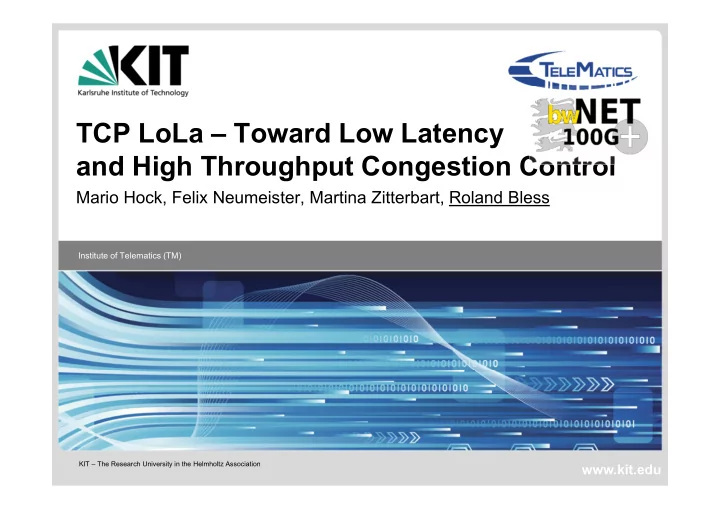

TCP LoLa – Toward Low Latency and High Throughput Congestion Control Mario Hock, Felix Neumeister, Martina Zitterbart, Roland Bless Institute of Telematics (TM) KIT – The Research University in the Helmholtz Association www.kit.edu
Motivation High Throughput and Low Delay Typically considered as conflicting goals or trade-off Not necessarily so: mitigate this trade-off Approaches: AQM, Tweaks to existing CC (e.g., Alternative Back- off with ECN), New congestion controls Investigate how far we can get with a congestion control Low queuing delay High utilization/throughput Scalable (also 10 Gbit/s and beyond) RTT Fairness Should work with regular tail-drop queues Focus: Wide area networks (not Data Center) 2 IETF 100 Singapore - ICCRG Institute of Telematics (TM) http://tm.kit.edu/
Objective and Challenges General goal Determine a suitable amount of inflight data achieving high bottleneck link utilization avoid creating standing queues keep queuing delay low Configurable fixed target delay value Congestion: persistent queuing delay above fixed target Challenge Convergence to fairness: total amount of inflight data okay, but maybe unequal rate shares Increase inflight data of one sender while reducing it for others Interaction with small queue is more difficult Without sacrificing the low delay goal! 3 IETF 100 Singapore - ICCRG Institute of Telematics (TM) http://tm.kit.edu/
TCP LoLa (Low Latency) Scalable approach based on queuing delay thresholds Bottleneck buffer �target �low out in Link utilization unknown Congestion High throughput, low delay e.g., sender sets �target = 5 ms Estimate queuing delay using min filter over fixed time period measure standing queue heuristic to adapt to network path changes (e.g., increasing ��� ��� ) Congestion window-based approach packet pacing is beneficial, but not necessary 4 IETF 100 Singapore - ICCRG Institute of Telematics (TM) http://tm.kit.edu/
�target �low TCP LoLa (Low Latency) Flow States Link utilization unknown Congestion High throughput, low delay Novel mechanism: See next slide �delay � �low � Slow Start Cubic Increase Fair Flow Balancing ���max � ���min �delay � �target � > 2 �low CWnd Hold [fixed waiting time �sync ]/ Action: Tailored Decrease Reliably detect Drain queue completely, congestion event Keep utilization high + Synchronization 5 IETF 100 Singapore - ICCRG Institute of Telematics (TM) http://tm.kit.edu/
Fair Flow Balancing Novel convergence to fairness mechanism Equalize amount of data that each flow may queue at the bottleneck Dynamically scale allowed amount of data w.r.t. given delay target Knowledge about current shares not available Key concepts Flow with more than fair share keeps CWnd Flow with smaller than fair share increases CWnd Allowed amount of data in queue � (fair queue share) is time dependent: � � X�t�� � , � : time since �target exceeded, � : constant 6 IETF 100 Singapore - ICCRG Institute of Telematics (TM) http://tm.kit.edu/
Testbed Setup Implemented as Linux Kernel module (Ubuntu 16.04) WAN link 21ms RTT Packet pacing enabled Traffic generated with iperf3 �low = 1ms, �target = 5ms , �sync = 250ms, �measure = 40ms 7 IETF 100 Singapore - ICCRG Institute of Telematics (TM) http://tm.kit.edu/
Evaluation Results – Throughput/Fairness TCP LoLa TCP Vegas High Throughput Link cannot be fully utilized Convergence to Fairness Misinterprets jitter as congestion 8 IETF 100 Singapore - ICCRG Institute of Telematics (TM) http://tm.kit.edu/
Low (Queuing) Delay TCP LoLa CUBIC TCP Delay kept around target Fills buffer completely (~5ms queuing delay) 9 IETF 100 Singapore - ICCRG Institute of Telematics (TM) http://tm.kit.edu/
Queuing Delay – RTT Independent Single flow, base RTT varied: 5ms, 61ms, 101ms LoLa keeps delay around target (~5ms queuing delay) Queuing delay is independent of Base RTT (and rate – not shown here) Number of senders (next slide) 10 IETF 100 Singapore - ICCRG Institute of Telematics (TM) http://tm.kit.edu/
Several Flows Starting in Succession RTTs measured at TCP senders BBR TCP LoLa LoLa still controls overall queuing Starting flows fill the buffer delay Delay kept around 2��� ��� No packet loss > 1 Mio retransmissions 11 IETF 100 Singapore - ICCRG Institute of Telematics (TM) http://tm.kit.edu/
RTT Fairness TCP LoLa CUBIC TCP Flow 1: 21 ms base RTT RTT unfairness Flow 2: 101 ms base RTT Convergence to similar congestion windows Small buffer: 12.5 Mbyte No convergence to fair rate shares Convergence to fair shares 12 IETF 100 Singapore - ICCRG Institute of Telematics (TM) http://tm.kit.edu/
Conclusion and Outlook First tests of the overall concepts [1] Parameters not thoroughly optimized Not a full-fledged TCP variant yet Further investigations Use of one-way delay instead of RTT measurements Influence of delayed and compressed ACKs Performance in wireless environments Multiple bottleneck scenarios Coexistence with loss-based variants (separate queues, AQMs, …) [2] Planned Use of explicit feedback from the network 13 IETF 100 Singapore - ICCRG Institute of Telematics (TM) http://tm.kit.edu/
References [1] M. Hock, F. Neumeister, M. Zitterbart, R. Bless: „TCP LoLa: Congestion Control for Low Latencies and High Throughput“, IEEE 42nd Conference on Local Computer Networks, Singapore, Oct 9–12, 2017 [2] M. Hock, R. Bless, M. Zitterbart, „Toward Coexistence of Different Congestion Control Mechanisms”, 2016 IEEE 41st Conference on Local Computer Networks, pp. 567–570, Dubai, United Arab Emirates, November 2016 14 IETF 100 Singapore - ICCRG Institute of Telematics (TM) http://tm.kit.edu/
BACKUP SLIDES 15 IETF 100 - ICCRG, Singapore Institute of Telematics (TM) http://tm.kit.edu/
Formulas RTT measurements � �min�RTT�� � � | � � ∈ ����measure, ��� ��� ��� � � � ��� ��� ≔ min ���� ��� , ��� ��� � � � Reset ��� ��� if ��� hasn‘t been measured ��� � close ��� ��� for 100 tailored decreases �delay = ��� � � � � ��� ��� ��� Cubic Increase / Tailored Decrease CWnd � � � · � � � � � CWndmax · CWndmax � � � � CWndmax � ��� ��� · � /� � ��� ��� Fair Flow Balancing � � X�t�� � , � : time since �target exceeded, X allowed amount of queued data, � : constant 16 IETF 100 Singapore - ICCRG Institute of Telematics (TM) http://tm.kit.edu/
Recommend
More recommend